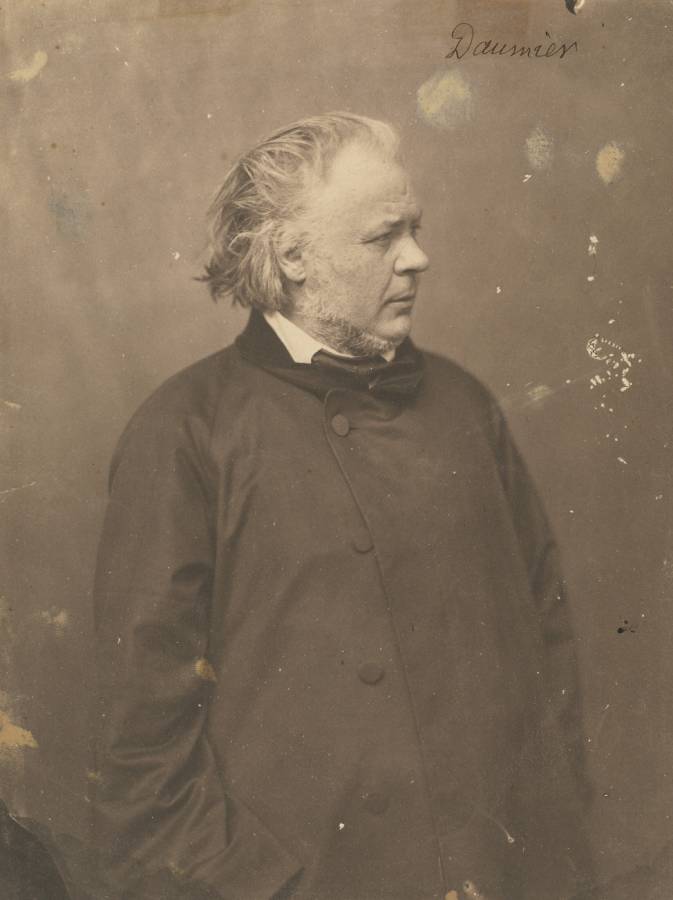Nadar (1820-1910)
Honoré Daumier
1856–1858
Salted paper print, 24.4 x 17.9 cm
National Gallery of Art, Washington
This portrait of the renowned caricaturist and painter Honoré Daumier was possibly not a commissioned work, but the result of a voluntary engagement with a fellow artist who paid considerably less than the 100 francs that Félix Tournachon, known as Nadar, normally charged.1 Félix, who placed great significance on details of clothing and demeanor, depicted Daumier before a neutral backdrop, wearing a simple coat that barely conceals his bulk, with his penetrating and intelligent gaze undiminished by his heavy features and unkempt hair. It is a sensitive tribute to the modesty and humanity of an artist Félix greatly admired. At the time that Félix made this portrait, he was embroiled in a legal battle with his younger brother, Adrien, over the exclusive right to the name Nadar.2 Félix was already celebrated for his drawings and caricatures for satirical newspapers when he arranged for Adrien, a painter, to learn the photographic process3 and to open his own photographic studio. When the business began to fail, the two collaborated, and Félix supplied financial backing, contacts, and his pseudonym, Nadar. After he was asked by Adrien to relinquish his share in the studio, Félix was prompted to take legal action when Adrien continued the practice alone using the name Nadar jeune. In his lawsuit, Félix wrote that although the techniques of photography could be learned, other qualities could not: [I]t’s the sense of light, it’s the artistic appreciation of the effects produced by different and combined qualities of light, it’s the applying of this or that effect according to the nature of the face that you have to reproduce as an artist. What can be learned still less is the moral intelligence of your subject, it’s the swift tact that puts you in communion with the model, makes you size him up, grasp his habits and ideas in accordance with his character, and allows you to render, not an indifferent plastic reproduction that could be made by the lowliest laboratory worker, commonplace and accidental, but the resemblance that is most familiar and most favorable, the intimate resemblance.4 This interest in capturing the subject’s inner character, honed by his experience as a caricaturist, may have had its roots in his studies as a medical student at a hospital specializing in the new field of psychiatry. Félix’s congenial nature, and the unusually large size5 of his prints, attracted celebrities and other dignitaries to his studio and made him one of the most sought-after portraitists of his time. He described putting a sitter at ease during a session: “One sits down, one chats, one laughs, all while readying the lens,” so that the subject, “warmed by all the affection,” radiates “all his natural benevolence.”6 Soon after the court ruled that Félix was “the only, the true Nadar,” he moved to a vast studio, the expenses of which forced him to broaden his clientele and adopt conventions of the period, including shading the background to create an oval vignette, and experimenting with color processes and artificial lighting. His interest waned; leaving the day-to-day activities of the studio to assistants, he concentrated on photographing the landscape from a balloon, and on photographing the catacombs and sewers of Paris using new techniques in artificial lighting. He returned to the studio only when a sitter particularly intrigued him. After his son Paul took over the business in 1895, Félix lived in semiretirement and wrote articles and books until his death at age 89. (Text by Julia Thompson, published in the National Gallery of Art exhibition catalogue, Art for the Nation, 2000)
Notes:
1. Maria Morris Hambourg et al., Nadar [exh. cat., The Metropolitan Museum of Art] (New York, 1995), 25.
2. Nadar was derived from the artist’s family name, Tournachon: Félix added the nonsensical suffix, “dard” or “dar”; thus Tournachondar became Nadard and finally Nadar.
3. Adrien learned the process from Gustave Le Gray, who was known primarily as a landscape photographer. Félix himself learned the process from the well-known portrait photographer Adolphe-Auguste Bertsch and opened a studio in his own home.
4. Revendication, 1857, part 2, o–p. Reprinted in New York 1995, 25.
5. From the mid-1850s to the late 1870s, most portrait photographers used the carte-de-visite format, albumen prints mounted on cards that measured about 4½ x 2½ inches.
6. Nadar, L’Hôtellerie des coquecigrues (1880), 286–287. Reprinted in New York 1995, 23.
See also:
• Daumier, Honoré (1808-1879)
